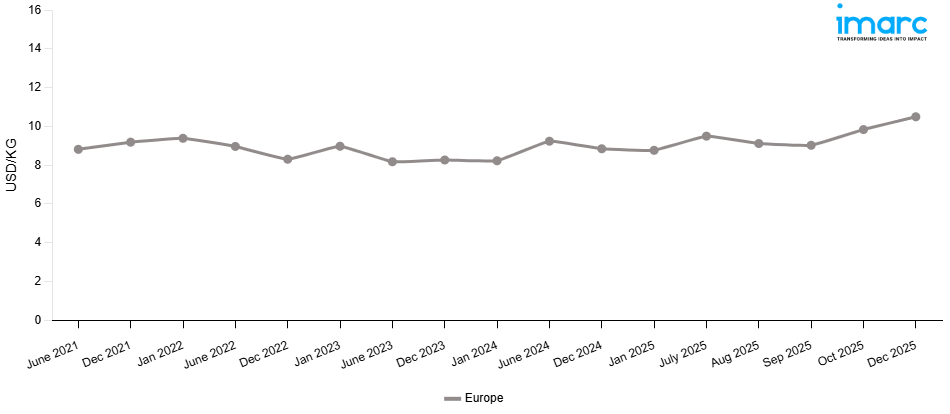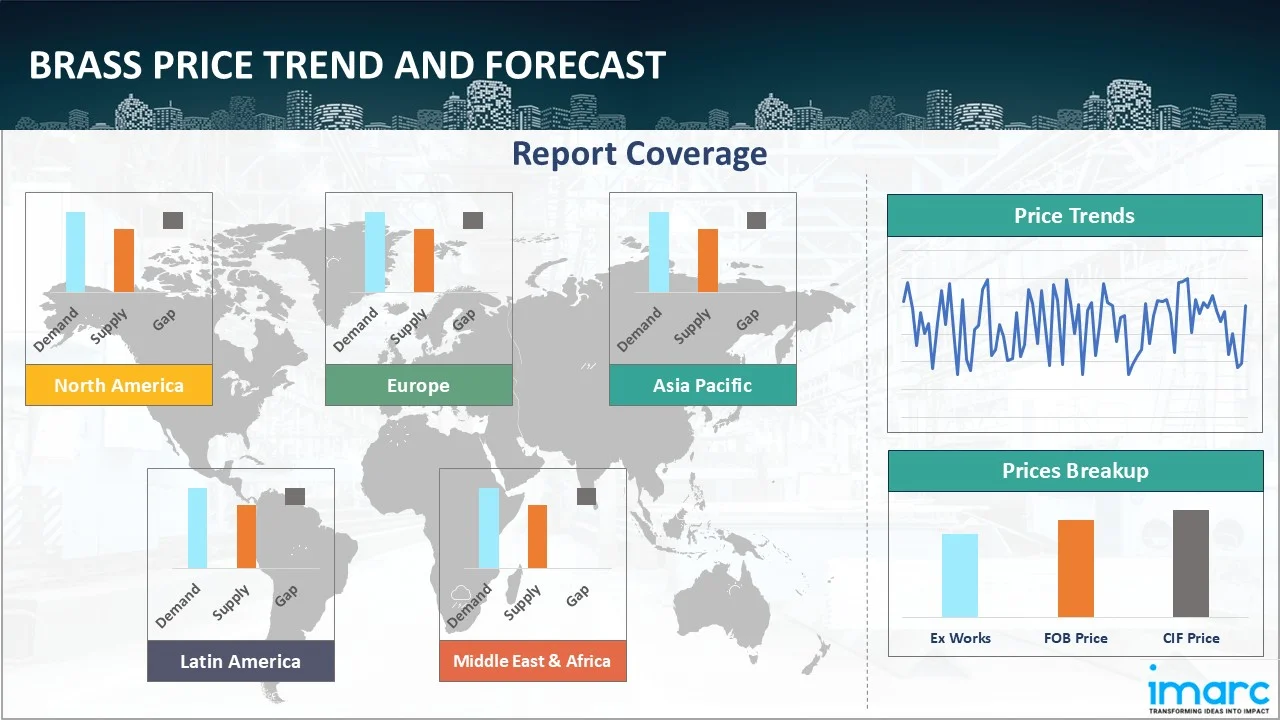
Brass Prices, Trend, Chart, Demand, Market Analysis, News, Historical and Forecast Data Report 2025 Edition
Brass Price Trend, Index and Forecast
Track real-time and historical brass prices across global regions. Updated monthly with market insights, drivers, and forecasts.
Brass Prices December 2025
| Region | Price (USD/Kg) |
|---|---|
| Europe | 10.50 |
Brass Price Index (USD/KG):
The chart below highlights monthly brass prices across different regions.

Get Access to Monthly/Quarterly/Yearly Prices, Request Sample
Market Overview Q3 Ending September 2025
Europe: The decline was driven by weak downstream demand from the automotive and construction sectors, both of which experienced lower output amid persistent inflationary pressures in Germany, France, and Italy. Logistics costs within the EU remained stable, although truck driver shortages continued to inflate inland freight costs. Furthermore, a stronger euro against the US dollar in August temporarily improved import competitiveness from Asian suppliers, adding pricing pressure to domestic producers. Compliance costs for REACH environmental regulations and certification requirements also factored into pricing adjustments, particularly for suppliers serving the electronics and plumbing industries.
Brass Price Trend, Market Analysis, and News
IMARC's latest publication, “Brass Prices, Trend, Chart, Demand, Market Analysis, News, Historical and Forecast Data Report 2025 Edition,” presents a detailed examination of the brass market, providing insights into both global and regional trends that are shaping prices. This report delves into the spot price of brass at major ports and analyzes the composition of prices, including FOB and CIF terms. It also presents detailed brass prices trend analysis by region, covering North America, Europe, Asia Pacific, Latin America, and Middle East and Africa. The factors affecting brass pricing, such as the dynamics of supply and demand, geopolitical influences, and sector-specific developments, are thoroughly explored. This comprehensive report helps stakeholders stay informed with the latest market news, regulatory updates, and technological progress, facilitating informed strategic decision-making and forecasting.

Brass Industry Analysis
The global brass industry size reached USD 8.45 Billion in 2025. By 2034, IMARC Group expects the market to reach USD 15.15 Billion, at a projected CAGR of 6.20% during 2026-2034. The market is driven by increasing demand from the construction, automotive, and electrical sectors, where brass is valued for its corrosion resistance, machinability, and conductivity. Expanding applications in renewable energy equipment, plumbing systems, and precision engineering further support market expansion, alongside urbanization trends in emerging economies.
Latest developments in the Brass Industry:
- May 2025: JTL Industries launched ultra-thin, non-ferrous brass foil specifically designed for the defense and industrial sectors. Designed for EMI/RFI shielding and military electronics applications, the brass foil enhances JTL’s value-added product portfolio, supporting its growth into specialized market segments.
- October 2024: Small Industries Development Bank of India (SIDBI), in support with the Youthcove Foundation and Assam’s Department of Industries, Commerce, and Public Enterprise, launched a comprehensive support program aimed at enhancing design capabilities and providing critical business insights for Assam’s indigenous brass and bell metal industry.
Product Description
Brass is a copper-zinc alloy recognized for its bright gold-like appearance, durability, and excellent machinability. Its unique combination of strength, corrosion resistance, and acoustic properties makes it a versatile material in global manufacturing. Brass plays a significant role in industrial consumption, ranking among the most widely used non-ferrous alloys. Its primary applications span across construction, plumbing, automotive, marine, and electrical sectors, where it is used in fittings, valves, radiators, ammunition casings, and decorative items. Its resistance to corrosion enhances product longevity, while its conductivity ensures efficiency in electrical applications, making it indispensable in both traditional and modern industries.
Report Coverage
| Key Attributes | Details |
|---|---|
| Product Name | Brass |
| Report Features | Exploration of Historical Trends and Market Outlook, Industry Demand, Industry Supply, Gap Analysis, Challenges, Brass Price Analysis, and Segment-Wise Assessment. |
| Currency/Units | US$ (Data can also be provided in local currency) or Metric Tons |
| Region/Countries Covered | The current coverage includes analysis at the global and regional levels only. Based on your requirements, we can also customize the report and provide specific information for the following countries: Asia Pacific: China, India, Indonesia, Pakistan, Bangladesh, Japan, Philippines, Vietnam, Thailand, South Korea, Malaysia, Nepal, Taiwan, Sri Lanka, Hongkong, Singapore, Australia, and New Zealand* Europe: Germany, France, United Kingdom, Italy, Spain, Russia, Turkey, Netherlands, Poland, Sweden, Belgium, Austria, Ireland, Switzerland, Norway, Denmark, Romania, Finland, Czech Republic, Portugal and Greece* North America: United States and Canada Latin America: Brazil, Mexico, Argentina, Columbia, Chile, Ecuador, and Peru* Middle East & Africa: Saudi Arabia, UAE, Israel, Iran, South Africa, Nigeria, Oman, Kuwait, Qatar, Iraq, Egypt, Algeria, and Morocco* *The list of countries presented is not exhaustive. Information on additional countries can be provided if required by the client. |
| Information Covered for Key Suppliers |
|
| Customization Scope | The report can be customized as per the requirements of the customer |
| Report Price and Purchase Option |
Plan A: Monthly Updates - Annual Subscription
Plan B: Quarterly Updates - Annual Subscription
Plan C: Biannually Updates - Annual Subscription
|
| Post-Sale Analyst Support | 360-degree analyst support after report delivery |
| Delivery Format | PDF and Excel through email (We can also provide the editable version of the report in PPT/Word format on special request) |
Key Benefits for Stakeholders:
- IMARC’s report presents a detailed analysis of brass pricing, covering global and regional trends, spot prices at key ports, and a breakdown of FOB and CIF prices.
- The study examines factors affecting brass price trend, including input costs, supply-demand shifts, and geopolitical impacts, offering insights for informed decision-making.
- The competitive landscape review equips stakeholders with crucial insights into the latest market news, regulatory changes, and technological advancements, ensuring a well-rounded, strategic overview for forecasting and planning.
- IMARC offers various subscription options, including monthly, quarterly, and biannual updates, allowing clients to stay informed with the latest market trends, ongoing developments, and comprehensive market insights. The brass price charts ensure our clients remain at the forefront of the industry.
Key Questions Answered in This Report
The brass price in December 2025 was 10.50 USD/KG in Europe.
The brass pricing data is updated on a monthly basis.
We provide the pricing data primarily in the form of an Excel sheet and a PDF.
Yes, our report includes a forecast for brass prices.
The regions covered include North America, Europe, Asia Pacific, Middle East, and Latin America. Countries can be customized based on the request (additional charges may be applicable).
Yes, we provide both FOB and CIF prices in our report.
Need more help?
- Speak to our experienced analysts for insights on the current market scenarios.
- Include additional segments and countries to customize the report as per your requirement.
- Gain an unparalleled competitive advantage in your domain by understanding how to utilize the report and positively impacting your operations and revenue.
- For further assistance, please connect with our analysts.
Why Choose Us
IMARC offers trustworthy, data-centric insights into commodity pricing and evolving market trends, enabling businesses to make well-informed decisions in areas such as procurement, strategic planning, and investments. With in-depth knowledge spanning more than 1000 commodities and a vast global presence in over 150 countries, we provide tailored, actionable intelligence designed to meet the specific needs of diverse industries and markets.
1000
+Commodities
150
+Countries Covered
3000
+Clients
20
+Industry
Robust Methodologies & Extensive Resources
IMARC delivers precise commodity pricing insights using proven methodologies and a wealth of data to support strategic decision-making.
Subscription-Based Databases
Our extensive databases provide detailed commodity pricing, import-export trade statistics, and shipment-level tracking for comprehensive market analysis.
Primary Research-Driven Insights
Through direct supplier surveys and expert interviews, we gather real-time market data to enhance pricing accuracy and trend forecasting.
Extensive Secondary Research
We analyze industry reports, trade publications, and market studies to offer tailored intelligence and actionable commodity market insights.
Trusted by 3000+ industry leaders worldwide to drive data-backed decisions. From global manufacturers to government agencies, our clients rely on us for accurate pricing, deep market intelligence, and forward-looking insights.
 Request Customization
Request Customization
 Inquire Before Buying
Inquire Before Buying
 Speak to an Analyst
Speak to an Analyst Request Brochure
Request Brochure




.webp)




.webp)












